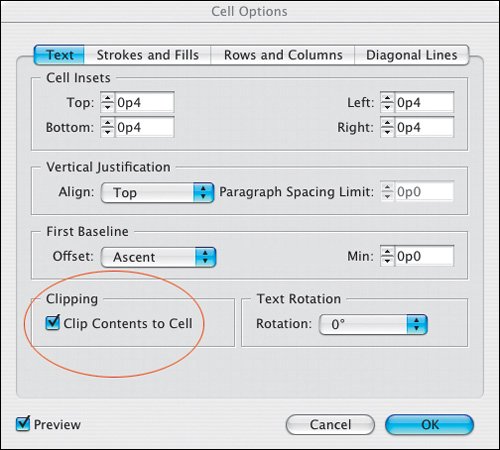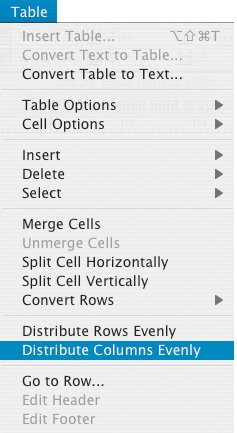Working with Rows and Columns
To select a column or columns, move the pointer to the top edge of the table, and your pointer becomes an arrow shape. Click to select the entire column. To select a row, move your pointer to the left edge of the table and click to select the row. Alternatively, you can click inside a table and choose Table > Select > Column or Row.
To specifically select Header, Body, or Footer rows, click inside the table and choose Table > Select > Header Rows, Body Rows, or Footer Rows.
Inserting and Deleting Rows and Columns
You can insert rows and columns using the menu options, or, if you want to be flash, on the fly by dragging while holding down Option (Alt) as you drag a row or column border. In addition, you can also create a new row by pressing Tab when the insertion point is in the last cell of the table.
To delete all or selected parts of your table, choose Table > Delete > Row, Column, or Table.
To delete cell contents without deleting cells, select the cells containing the text you want to delete and press Backspace or Delete.
Note
When adding columns, if you drag more than one and one-half times the width of the column being dragged, new columns with the same width as the original column are added.
Figure 12.22. Inserting Rows and Columns

Resizing Rows and Columns
To resize rows and columns, drag the row or column border to change the row height or column width. To keep the table at the same size, hold Shift while you drag. This affects only two rows (or two columns) at onceone row or column gets bigger while the other gets smaller. To resize all the rows and columns proportionally, hold Shift while dragging the bottom table edge or the right table edge respectively.
To resize the whole table, position the pointer over the lower right corner of the table so that the pointer becomes an arrow, and then drag to increase or decrease the table size. To maintain the table's height and width proportions, hold Shift. Note, this doesn't work if your table spans more than one frame.
Changing Row Height
Choosing At Least specifies a minimum row height that will grow as you add text or increase the point size of the text you already have. If you copy or Place a graphic into the table cell, the row height will grow to accommodate the graphic. But the column width will not. With an overset graphic you can either choose to Clip Contents to Cell to crop the graphic to the table cell width or adjust the column width to fit the graphic.
Tip
Choosing Exactly from the Control palette or Table palette sets a fixed row height. Fixed row heights don't grow when you add text, and a small red dot will appear in the lower right corner of the cell if it is overset. With an overset cell you have two options: Make the content smaller or the table cell bigger.
Distributing Rows or Columns Evenly
If you want your selected rows or columns to have a uniform height or width, choose Table > Distribute Rows Evenly or Distribute Columns Evenly.
Figure 12.23. Clip Contents to Cell.

Figure 12.24. Distribute Columns Evenly.

Part I: Character Formats
Getting Started
- Getting Started
- An InDesign Type Map: Where to Find Stuff
- Viewing Your Page
- Creating a Typography Workspace
- Up Next
Going with the Flow
- Going with the Flow
- A Blank Sheet: Typing on Your Page
- Text Flow
- Threading Text Frames
- Using Placeholder Text
- Pasting Text
- Importing Word Text
- Up Next
Character Reference
- Character Reference
- Less is More, Maybe
- Type Anatomy
- Type Classification
- Character Formatting Options
- Readability
- Up Next
Getting the Lead Out
- Getting the Lead Out
- How Much Is Enough?
- (Not) Using Auto Leading
- Keep It Consistent, Except. . .
- Leading Menu Options and Keyboard Shortcuts
- See Also
- Up Next
Kern, Baby, Kern
- Kern, Baby, Kern
- When to Kern
- Metrics Kerning
- Optical Kerning
- Manual Kerning
- How Much to Kern
- Tracking
- When to Track
- Controlling Widows and Orphans
- Up Next
Sweating the Small Stuff: Special Characters, White Space, and Glyphs
- Sweating the Small Stuff: Special Characters, White Space, and Glyphs
- Typographers Quotes
- Apostrophes
- Dashes
- Ellipses
- End Marks
- White Space Characters
- The Glyphs Palette
- Footnotes
- Footnote Options
- Up Next
OpenType: The New Frontier in Font Technology
- OpenType: The New Frontier in Font Technology
- Ligatures
- Discretionary Ligatures
- Ordinals/Raised and Lowered Characters
- Swash Characters
- Fractions
- Oldstyle Figures
- Contextual Alternates
- Opticals
- Glyph Positioning
- Stylistic Sets
- Up Next
Part II: Paragraph Formats
Aligning Your Type
- Aligning Your Type
- Centering Type
- Clean Shaven or Rugged: Justified vs. Ragged Type
- How InDesign Justifies Type
- Balancing Ragged Lines
- Right-Aligned Type
- Optical Margin Alignment
- Indent to Here
- Vertical Alignment
- Up Next
Paragraph Indents and Spacing
First Impressions: Creating Great Opening Paragraphs
- First Impressions: Creating Great Opening Paragraphs
- Creating a Simple Drop Cap
- Drop Cap Aesthetics
- Tricks with Drop Caps
- Up Next
Dont Fear the Hyphen
Mastering Tabs and Tables
- Mastering Tabs and Tables
- Setting Tabs
- Creating Decimal Tabs
- Using Tab Leaders
- Reply Forms
- Numbered Lists
- Right Indent Tab
- Working with Tables
- Creating a Table
- Working with Rows and Columns
- Working with Table Cells
- Up Next
Part III: Styles
Stylin with Paragraph and Character Styles
- Stylin with Paragraph and Character Styles
- Creating Styles
- Applying Styles
- Editing Styles
- Redefining Styles
- Creating Default Styles
- A Typical Style Sheet
- Up Next
Mo Style
Part IV: Page Layout
Setting Up Your Document
- Setting Up Your Document
- Choosing a Page Size
- Determining Margins
- Determining Column Width
- Changing Columns
- Break Characters
- Page Numbers
- Section Markers
- Up Next
Everything in Its Right Place: Using Grids
- Everything in Its Right Place: Using Grids
- Things to Consider
- Your Grid Tool Kit
- Calculating the Height of the Type Area
- Align to Grid
- First Baseline Options
- Snap to Guides
- Up Next
Text Wraps: The Good, the Bad, and the Ugly
- Text Wraps: The Good, the Bad, and the Ugly
- Applying Text Wraps
- Wrapping Type Around Irregularly Shaped Graphics
- Text Wrap Preferences
- Ignoring Text Wrap
- Anchored Objects
- Up Next
Type Effects
EAN: 2147483647
Pages: 186
